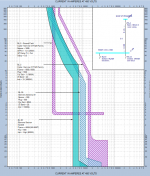Per NEC 215.10
Ground-Fault Protection of Equipment. Each
feeder disconnect rated 1000 amperes or more and installed
on solidly grounded wye electrical systems of more than
150 volts to ground, but not exceeding 600 volts phase-tophase,
shall be provided with ground-fault protection of
equipment in accordance with the provisions of 230.95.
I face a situation, 480V system, my 1600A main breaker has LSIG trip, other downstream breakers does not have ground fault protection. if i turn off ground fault protection, I can have selective coordination with all downstream breaker. If I turn on the ground fault protection, then i do not have selective coordination.
However, per code, I need to have ground-fault protection.
Question, is there any solution?
Ground-Fault Protection of Equipment. Each
feeder disconnect rated 1000 amperes or more and installed
on solidly grounded wye electrical systems of more than
150 volts to ground, but not exceeding 600 volts phase-tophase,
shall be provided with ground-fault protection of
equipment in accordance with the provisions of 230.95.
I face a situation, 480V system, my 1600A main breaker has LSIG trip, other downstream breakers does not have ground fault protection. if i turn off ground fault protection, I can have selective coordination with all downstream breaker. If I turn on the ground fault protection, then i do not have selective coordination.
However, per code, I need to have ground-fault protection.
Question, is there any solution?


